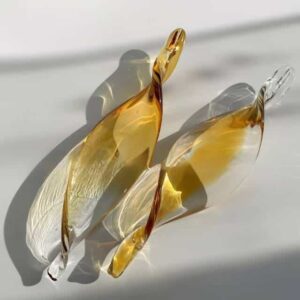The Enchanting Alchemy of Glassblowing: A Deep Dive into its Art and Science
Published on 2023年 8月 27日 by iartglass

Introduction
From the bustling markets of ancient Mesopotamia to the luxurious galleries of modern-day New York, glassblowing has always been a mesmerizing craft that captures the hearts and imaginations of countless onlookers. This art form, though ancient, is anything but outdated; its appeal endures, combining both artistry and the precision of science.
A Brief History of Glassblowing
Glassblowing is believed to have originated around 50 B.C. in the regions of Syria, Mesopotamia, or Palestine. From its modest beginnings, this craft quickly spread to ancient Rome, where it blossomed into a prominent industry. Artists in these regions experimented with various techniques, producing everything from simple containers to intricate sculptures. As civilizations evolved, so did their methods of crafting glass, infusing their cultural essence and creativity into each piece.
Fast forward to today, and we see contemporary artists, including the renowned Siga Art Glass, taking inspiration from the past while innovating with modern techniques and aesthetics.
The Balance of Artistry and Science
Glassblowing isn’t just about the artist’s touch; it’s a delicate dance between heat, pressure, and timing. The scientific principles behind turning raw materials into clear, shimmering art are astounding. From understanding the molten state of glass to predicting how it’ll react to different colors and shapes, the artist must wear both the hat of a creator and that of a scientist.
The Basics of Glassblowing
What is Glass? Understanding its Core Components
Glass, in its most basic form, is made from silica (sand), soda ash, and limestone. These materials are melted together in a furnace at temperatures surpassing 1700°C (3092°F). When this molten mixture cools, it hardens without crystallizing, resulting in the transparent material we know as glass.
Different additives can be introduced to this mix, like metallic compounds, to give the glass various colors and properties.
Tools of the Trade: An Overview of Essential Glassblowing Tools
- Blowpipe: A long metal tube used for gathering molten glass and blowing air into it.
- Punty (or Pontil): A rod used to hold and shape the glass piece.
- Shears: For cutting and trimming the glass.
- Marver: A flat, metal surface on which glass is rolled to shape and cool.
- Blocks: Wooden tools soaked in water, used to shape and cool the glass.
- Jack Blades: Metal tools used to shape, cut, and form the “neck” of a blown piece.
For those interested in diving deeper into the myriad tools and intricate processes, Siga Art Glass offers an insightful guide on crafting elegance with hand-blown glass.
The Science Unveiled
Glassblowing, as mentioned, isn’t just an artistic endeavor. It’s a delicate alchemy requiring a deep understanding of materials and processes to create those wondrous pieces. Let’s peel back the curtain and explore the scientific principles that make this art possible.
The Role of Heat: Understanding Temperature’s Impact on Glass Viscosity
Heat is a central player in the glassblowing process. When glass is heated, its viscosity – or resistance to flow – decreases, allowing it to be shaped and molded. But it’s not a simple on-and-off switch; different temperatures grant different levels of malleability:

To master glassblowing, one must understand these temperature nuances, ensuring the material is always at the right consistency for the task at hand.
Expansion and Contraction: The Importance of Annealing to Prevent Cracks
As glass is shaped and cooled, it undergoes expansion and contraction. If these processes are uneven or too rapid, stress is introduced, leading to cracks. This is where annealing comes into play.
Annealing involves heating the glass to a specific temperature where its internal stresses relax and then slowly cooling it down in a controlled manner. This process, typically done in a specialized annealing oven, ensures that the finished glass piece is free from internal stress and less prone to cracking.
If you’ve ever marveled at the impeccable finish of pieces from Siga Art Glass, their meticulous annealing process is a significant reason behind it.
Color Magic: How Different Metals and Minerals Influence Glass Colors
Glass, in its natural state, is usually clear. But the vibrant colors we often see in hand-blown glass are a result of introducing various metals and minerals. Here’s a quick rundown:
Artisans can achieve a vast spectrum of colors by controlling the amount and combination of these additives.
Siga Art Glass: A Modern Torchbearer
Nestled in the heart of contemporary glassblowing renaissance, Siga Art Glass stands as a testament to both tradition and innovation.
Evolution of the Brand’s Techniques and Designs
From its inception, Siga Art Glass has been driven by a passion for impeccable craftsmanship. The brand has continually evolved, melding age-old techniques with contemporary designs. From intricate hand-blown glass lamp parts to mesmerizing installations, each piece tells a story of dedication and artistry.
The Commitment to Sustainable and Innovative Glassblowing
In an era where sustainability is paramount, Siga Art Glass champions eco-friendly practices. By sourcing responsible materials and optimizing production processes, the brand ensures minimal environmental impact. Moreover, their quest for innovation has led to unique pieces that not only adorn spaces but also inspire conversations.
Whether you’re an art enthusiast or a sustainability advocate, the work of Siga Art Glass resonates on multiple levels, making them a beacon in the modern world of glassblowing.
Steps in the Glassblowing Process
The creation of a glass masterpiece is a journey, encompassing multiple stages, each vital in shaping its final form. Let’s embark on this fascinating process, tracing each step that an artisan takes in the realm of glassblowing.
Gathering: The First Scoop of Molten Glass
Every masterpiece starts with a humble beginning. In glassblowing, this is the act of ‘gathering’. Using the blowpipe, the artisan dips into the furnace, scooping up a gob of molten glass. This is akin to collecting honey on a dipstick, but at searing temperatures.
Shaping and Inflating: Breathing Life into the Glass
With the gather on the blowpipe, the next step is to shape and inflate. Rolling the
gather on a marver, the glassblower begins to mold its basic form. Air is then introduced by blowing gently into the blowpipe. This breath of life causes the glass to expand, forming a bubble, the heart of any blown glass piece.
Flashing: The Art of Reheating and Maintaining Uniformity
Uniformity is key in glassblowing. To ensure the piece remains at a consistent temperature and malleability, it’s returned to the ‘glory hole’, a reheating chamber, in intervals. This process, known as flashing, prevents the glass from cooling too quickly, allowing for more intricate work.
Transferring: Switching the Pole
Once the bottom half of the piece is formed, it’s time to work on the opening. The piece is transferred from the blowpipe to another rod, the punty. This switch allows artisans to shape the piece’s mouth and top section.
Final Shaping: Creating Intricate Designs and Details
The final touches are what transform a simple glass bubble into art. Using various tools, the glassblower refines the shape, adds patterns, and embeds colors. Whether crafting the smooth curves of a Siga Art Glass chandelier or the intricate details of their hand-blown lampshades, this stage demands the utmost precision and creativity.
Applications in Modern Decor
Glass, with its ethereal beauty and versatile nature, has found a cherished place in modern décor. From functional pieces to abstract sculptures, its presence can elevate any living space.
From Functional Pieces to Pure Art: The Versatility of Blown Glass
Hand-blown glass isn’t restricted to decorative vases or bowls. Today, it graces our homes in the form of elegant lighting fixtures, intricate centerpieces, and even functional items like tumblers and plates. Its adaptability is a testament to both the material itself and the artisans who mold it.
Incorporating Hand-Blown Glass into Your Living Space
When integrated thoughtfully, hand-blown glass can become the focal point of a room. Consider:
- Lighting: A hand-blown glass chandelier or pendant can redefine a space with its luminescence and design.
- Tabletop Decor: Vases, bowls, or sculptures can provide an exquisite touch to dining or coffee tables.
- Functional Art: Pieces like Murano chandeliers or Siga’s pendant globe lights serve a purpose while doubling as artwork.
Embracing the artistry of brands like Siga Art Glass ensures that each addition to your home isn’t just a piece, but a story, a testament to the timeless allure of glassblowing.
Challenges in Glassblowing
Glassblowing is a dance of passion and peril, demanding not only artistic talent but also a keen understanding of its medium and process. Like any art form, it is not without its challenges.
The Risks and Demands of Working with Molten Material
Working with molten glass, which can soar to temperatures exceeding 1600°C (2912°F), is inherently risky. The radiant heat, the possibility of burns, and the threat of shattered glass are constant companions to a glassblower. Ensuring safety requires:
- Appropriate Protective Gear: This includes heat-resistant gloves, safety glasses, and aprons.
- Continuous Awareness: Artisans must always be alert to their surroundings, the temperature of the glass, and the state of their tools.
- Proper Ventilation: Working with high heat and certain materials can release fumes. Effective ventilation systems are essential in any glassblowing studio.
Striking a Balance Between Creativity and Technique
Beyond the physical risks, glassblowing is an ongoing tussle between the heart and the hand. The artisan might envision a masterpiece, but achieving that vision requires impeccable technique. And sometimes, the glass has its own ideas. Managing inconsistencies in the glass, unexpected reactions in colorants, or the unpredictability of the material itself can be daunting. Yet, it’s this very challenge that often results in the most breathtaking pieces, like those showcased by Siga Art Glass.
Conclusion
Glassblowing, an art form that traces its roots to ancient civilizations, continues to captivate us with its mesmerizing blend of fire, air, and human touch. The transformation of a humble gather of molten glass into exquisite pieces, be it a delicate vase or a luminescent chandelier, is a testament to human creativity and resilience.
Looking ahead, the future of glassblowing is luminous. With brands like Siga Art Glass leading the charge, we see a harmonious amalgamation of traditional techniques with modern innovations. Sustainability, creative designs, and an ever-growing appreciation for the craft promise a continued evolution of this timeless art form.
As we reflect on the journey of glass, from its molten state to the myriad shapes and forms it can assume, we are reminded of the limitless potential of human creativity. In every twist, turn, and color of a hand-blown piece, we see not just the artist’s vision, but the culmination of centuries of knowledge, passion, and evolution.




